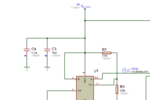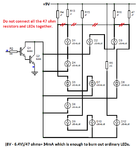d123
Advanced Member level 5
Get a calculator, spend an hour getting it wrong until something seems right, and confuse yourself even more like I have to do, then ask the question, my friend 
See what a 900 Ohm in parallel with a 580 becomes.
That's not the point anyway, maybe I'm wrong but I understand that the 180R will stay 180R (it's a series resistor), it limits the same amount of current to n number of parallel strings, whether that's 1 in series or 5 in parallel.
I'm saying this with a smile on my face, "You're still simulating this, having the LEDs and devices there in your hands, aren't you?" Get away from the computer and watch a few LEDs pass from the right colour to a brief worrisome orange then red then burnt out in a split second, it's fun. Experiment, if you aren't already.
See what a 900 Ohm in parallel with a 580 becomes.
That's not the point anyway, maybe I'm wrong but I understand that the 180R will stay 180R (it's a series resistor), it limits the same amount of current to n number of parallel strings, whether that's 1 in series or 5 in parallel.
I'm saying this with a smile on my face, "You're still simulating this, having the LEDs and devices there in your hands, aren't you?" Get away from the computer and watch a few LEDs pass from the right colour to a brief worrisome orange then red then burnt out in a split second, it's fun. Experiment, if you aren't already.

